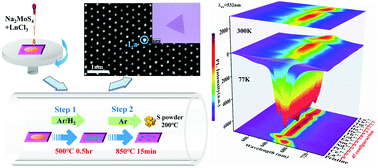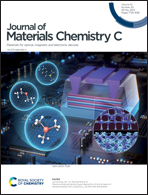Embedded lanthanoid ions modulated the periodic luminescence of transition metal dichalcogenide monolayers prepared from an aqueous orecursor†
Abstract
Trivalent lanthanoid ions (Ln3+) with substantial inherency have been utilized in luminescent materials and photonic devices for decades. Because the periodic physicochemical properties of lanthanoid compounds have been found to be closely related to the regular f-configuration of the elements, it is essential to study the interaction between the f-electrons and the circumstances for developing new applications. Two-dimensional transition metal dichalcogenides (2D-TMDs) manifest as excellent matrices for tunable electronic structures owing to their chemical accessibility and physical sensitivity. Herein, a novel method is proposed for the fabrication of Ln3+ substitutional doped MoS2 using a Na2MoS4 solution precursor. Monolayers doped with all Ln3+ ions (except Pm3+) are synthesized, which is confirmed by structural characterization. Their shrunk Raman frequency differences and the blue-shifting and intensity boosting of their photoluminescence (PL) peaks are observed. Periodic trends are discovered in the PL spectra, which are sensitive to specific elements. The results reveal the ordered interaction between f-orbitals and the host possessing an appreciable coulombic field, spin–orbital coupling, and a crystal field. This work offers a crucial extension of lanthanoid laws and a new approach to the modulation of the properties of 2D crystals.



 Please wait while we load your content...
Please wait while we load your content...